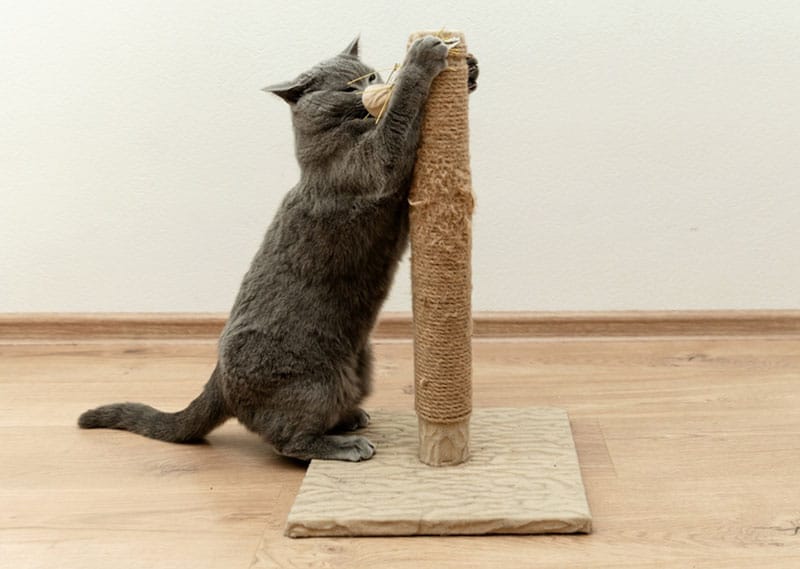As much as we love our feline friends, they can often send us into confusion with their curious behavior, whether it’s disruptive nighttime activities, being woken by a hungry cat pawing at your face, or an attention-seeking cat being disruptive while you work at your computer.
These issues can affect your relationship, but if you could set boundaries, it may make things easier. Well, you can! While it may be easier said than done, you can set boundaries with your cat, which we will explain in depth in this article.
Setting Boundaries for Cats
Many cat owners struggle with behavioral issues with their cats and wonder if they can set boundaries that their cats will understand. You can set boundaries with cats, but like with humans and dogs, deciding on boundaries requires understanding your cat’s nature.
It is your responsibility to understand your cat and what they like and dislike. By setting boundaries with your cat, you can avoid situations where you become frustrated by your cat doing something natural.
They can be minor behavioral issues that aren’t necessarily wrong but can cause interruptions in your routine or drive you to frustration, such as waking you up at night or jumping on the counters. It’s perfectly fine to have your limits and you can set boundaries with your cat to improve your relationship.

Before Setting Boundaries
Though all pet owners are keen to fix unwanted behaviors in their pets, it’s important to keep in mind that cats may act in an undesirable way for either medical reasons or behavioral reasons. Assuming your cat is acting the way they are solely due to behavioral issues is a common mistake that many owners fall prey to.
Anytime you notice a change in your cat’s behavior, or can’t seem to explain their behavior, it’s very important to seek veterinary input. Cats try to mask their illnesses, and sometimes, a change in their behavior can be due to an underlying health issue.
Attempts to correct their behavior should only be done once your veterinarian has ruled out veterinary issues.
Reasons for Setting Boundaries for Cats
Setting boundaries with your cat is vital to establishing and maintaining a good relationship between you and your feline friend. As cat owners, we can very easily get frustrated by behaviors that are completely natural for cats, but setting boundaries can prevent us from reaching our limit and becoming frustrated.
Boundaries help create an environment where your cat feels safe. If your cat feels safe, they have more time to practice self-care by eating, sleeping, and enjoying playtime on their own. Boundaries also work both ways.
Your cat will also have boundaries you should respect, such as not forcing them to sit with you or be held when they’re not in the mood. Boundaries are also especially important if you work from home since your cat can become quite a disturbance. Setting boundaries can be difficult but it’s not impossible.

FAQ (Frequently Asked Questions)
Can a Cat Be Trained?
Cats can be trained, but they require very quick corrections and acknowledgements when they’re being trained. Cats can learn to sit and follow commands like dogs, but they are more difficult to train. When most people talk about training cats though, they refer to housetraining them to ensure they don’t do things they’re not supposed to (such as jumping on a countertop).
Ideally, you must start training your cat as early as possible. Positive reinforcement should be used so that your cat stays motivated, and avoiding punishment-based training will prevent stress and the chance of your cat becoming fearful of you.
Cats should be given corrections quickly, often within 2-3 seconds of you observing them doing something they shouldn’t. Keep in mind that cats are clever, and sometimes, they can learn that misbehaving can get your attention as well.
How Do I Set Healthy Boundaries for My Cat?
To set healthy boundaries with your cat, you need to understand their temperament and personality. You should be able to recognize their limitations and work with them.
First, you need to consider what matters. Trying to force your cat to do something won’t work and will also encroach on their boundaries, which can stress them out. You also need to ask yourself if it’s worth it as it can take a lot of time and energy. In most cases, it’s best to use the services of a professional cat trainer for these sort of training sessions, as cats can be very difficult to retrain for some.
Consistency and patience are vital to setting boundaries. Setting a time to play, having a consistent feeding schedule, and reinforcing wanted behaviors help set boundaries.
- Remove your cat every time they jump on an area you don’t want them to be, like the counter or bed. With time and consistency, your cat will get the message. Alternatively, a stern (but not loud) “No” can get the message across.
- Try to deter your cat from your keyboard by offering a comfy bed nearby.
- Cats are natural climbers, so provide perches and scratching posts to prevent your cat from jumping on counters and scratching furniture.
- Keep your expectations rational. For instance, if your cat doesn’t have a scratching post and is scratching furniture, your first course of action should be to get your cat a scratching post.

How Do You Establish the Right Boundaries?
You have to do what’s right for you and your cat, so every cat owner will find different boundaries to set. It can take patience and energy to set boundaries, so it’s important to consider how important and necessary they are; otherwise, it can cause even more stress and frustration.
You should also take your cat’s instincts into account and be realistic. For example, you cannot expect your cat to stop scratching the furniture if you don’t provide a suitable alternative.
Sit down and consider the behaviors you are unhappy with. They could look something like this:
- Being woken up at night
- Biting when playing
- Jumping on the bed in the morning
- Jumping on the counters
- Stealing food from plates
- Climbing on curtains or furniture
This list will look different for every cat owner, but once you have it, you need to analyze it further and consider things like, is this a natural behavior for cats? This can help you figure out a plan and a way forward and put your expectations in check.
Conclusion
Setting boundaries with your cat can be done with a little patience, consistency, and understanding. Setting boundaries is not about prohibiting your cat’s natural behavior but finding a way for you both to live together happily and not with frustration or resentment.
At the end of the day, your cat probably loves you and wants to be close to you. It’s worth the effort to find a balance between respecting their boundaries and teaching them to respect yours. You can have a fulfilling and positive relationship with your cat by being consistent while setting realistic boundaries.
Featured Image Credit: Africa Studio, Shutterstock













